- Home
- Parents Home
- Allergy Center
- Asthma Center
- Cancer Center
- Diabetes Center
- A to Z Dictionary
- Emotions & Behavior
- First Aid & Safety
- Food Allergy Center
- General Health
- Growth & Development
- Flu Center
- Heart Health
- Homework Help Center
- Infections
- Diseases & Conditions
- Nutrition & Fitness Center
- Play & Learn Center
- School & Family Life
- Pregnancy Center
- Newborn Center
- Q&A
- Recipes
- Sports Medicine Center
- Doctors & Hospitals
- Videos
- Para Padres
- Home
- Kids Home
- Asthma Center
- Cancer Center
- Movies & More
- Diabetes Center
- Getting Help
- Feelings
- Puberty & Growing Up
- Health Problems of Grown-Ups
- Health Problems
- Homework Center
- How the Body Works
- Illnesses & Injuries
- Nutrition & Fitness Center
- Recipes & Cooking
- Staying Healthy
- Stay Safe Center
- Relax & Unwind Center
- Q&A
- Heart Center
- Videos
- Staying Safe
- Kids' Medical Dictionary
- Para Niños
- Home
- Teens Home
- Asthma Center
- Be Your Best Self Center
- Cancer Center
- Diabetes Center
- Diseases & Conditions
- Drugs & Alcohol
- Expert Answers (Q&A)
- Flu Center
- Homework Help Center
- Infections
- Managing Your Medical Care
- Managing Your Weight
- Nutrition & Fitness Center
- Recipes
- Safety & First Aid
- School & Work
- Sexual Health
- Sports Center
- Stress & Coping Center
- Videos
- Your Body
- Your Mind
- Para Adolescentes
Lungs and Respiratory System
What Is the Respiratory System?
When we breathe, the respiratory system takes in oxygen and sends out carbon dioxide. The cells in our bodies need fresh oxygen to stay alive. As cells do their jobs, they make and give off carbon dioxide. This exchange of oxygen and carbon dioxide is called respiration.
What Are the Parts of the Respiratory System?
The respiratory system includes the nose, mouth, throat, voice box, windpipe, lungs, and diaphragm.
How Does Breathing Happen?
The diaphragm (DYE-uh-fram) is a muscle between the chest and the abdomen that allows the body to move air in and out of the respiratory system. When you breathe in (inhalation), the diaphragm moves down toward the abdomen, and the rib muscles pull the ribs upward and outward. This makes the chest cavity bigger and pulls air through the nose or mouth into the lungs.
When you breathe out (exhalation), the diaphragm moves up and the chest wall muscles relax, causing the chest cavity to get smaller and push air out of the respiratory system through the nose or mouth.

The Respiratory System
We take thousands of breaths a day, thanks to the respiratory system.
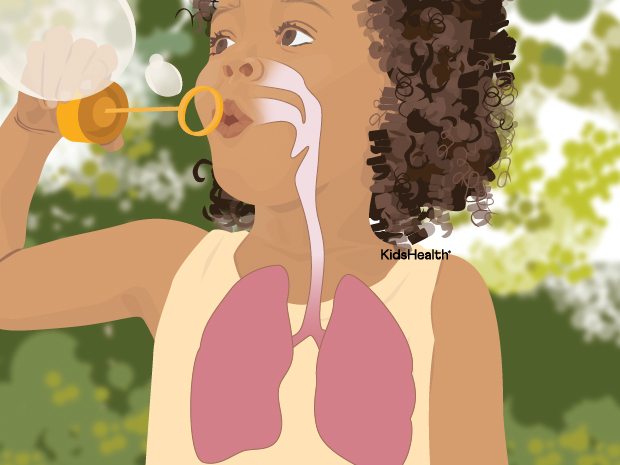
The Respiratory System
The nose, throat, and lungs are just a few parts of the body that make up the respiratory system. They work together to bring oxygen into the body and take carbon dioxide (a waste product) out.

The Respiratory System
The cells in the body need oxygen to do their job. Oxygen comes from the air. When we breathe in through the nose or mouth, we pull air into the throat and down the trachea.
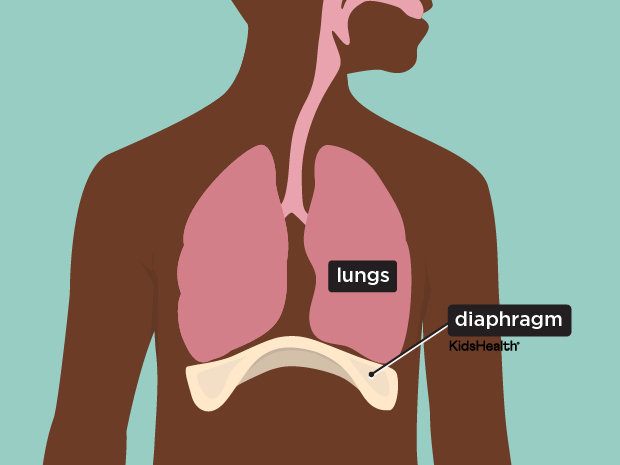
The Respiratory System
To pull air into the body (and push it out again), the body uses a strong muscle just below the lungs called the diaphragm.
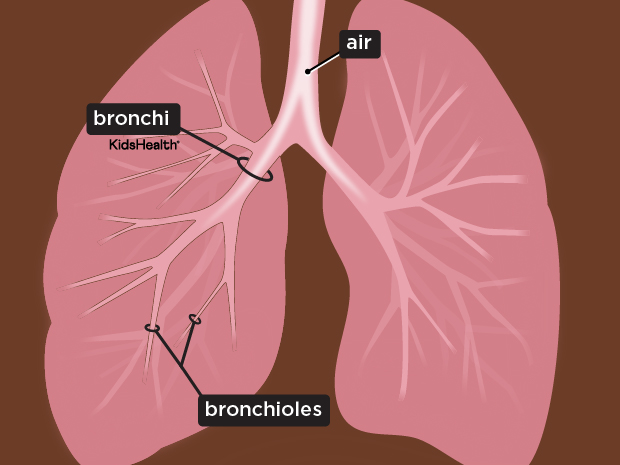
The Respiratory System
From the trachea, air moves into the lungs through tubes called bronchi. The bronchi lead to smaller tubes called bronchioles, which look like the branches of a tree.

The Respiratory System
At the ends of the bronchioles are tiny sacs called alveoli.
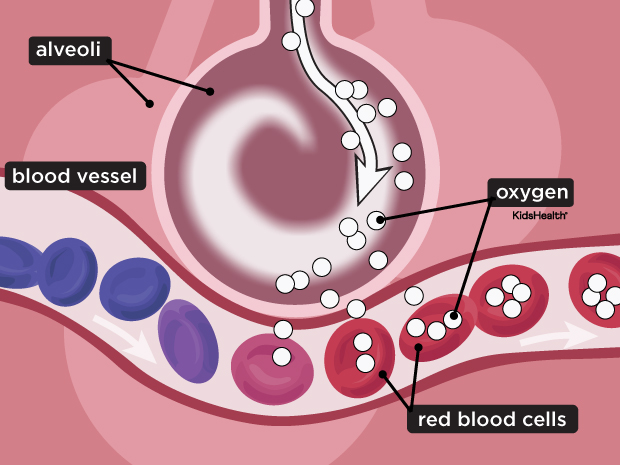
The Respiratory System
Oxygen gets into the blood through tiny blood vessels around the alveoli. Red blood cells pick up the oxygen and deliver it to the body's cells.

The Respiratory System
When we breathe out, the same thing happens — only in reverse. This is how the body gets rid of carbon dioxide. The blood collects carbon dioxide from all over the body and carries it back to the air in the alveoli.

The Respiratory System
From the alveoli, air moves out of the lungs through the bronchioles and bronchi.
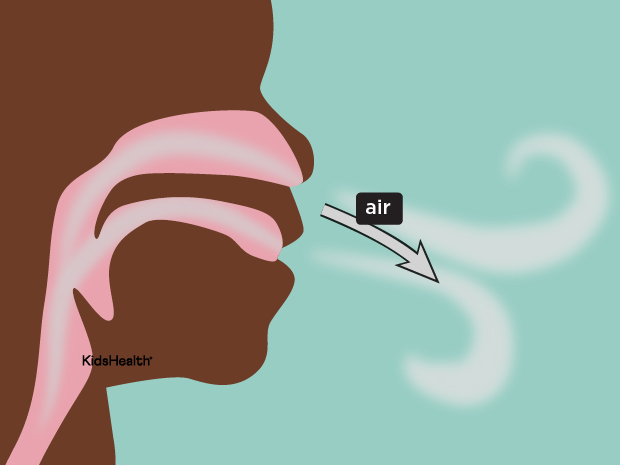
The Respiratory System
Finally, air leaves the body the same way it came in — through the nose or mouth.

The Respiratory System
Watch the respiratory system in action.

The Respiratory System
This KidsHealth program offers general information, not specific or personalized medical advice. Patients and their families should contact their health care providers for medical advice specific to their situations.
Where Does Air Go?
Air enters the respiratory system through the nose or the mouth, then travels down a pathway to the lungs. In the nostrils, air gets warmed and moistened. Tiny hairs in the nose called cilia (SIL-ee-uh) filter out dust and other particles.
The nasal cavity and mouth join at the area in the back of the throat called the pharynx (FAR-inks). The pharynx is part of two body systems (the respiratory system and the digestive system) because it carries both air and food.
At the bottom of the pharynx, two pipes split off — one for air and one for food. One pipe, the larynx, is for air only. It’s also called the voice box because it contains a pair of vocal cords that vibrate to make sounds when you talk. (The other pipe is called the esophagus and is the pathway that brings food to the stomach.) A small flap of tissue called the epiglottis (eh-pih-GLAH-tus) protects the larynx. When we swallow, the epiglottis covers the larynx to prevent food and liquid from going into the lungs.
The trachea (windpipe) is the part of the airway that continues below the larynx (LAIR-inks). The walls of the trachea (TRAY-kee-uh) have stiff rings of to keep it open. The trachea is also lined with cilia, which sweep fluids and foreign particles out of the airway to keep them out of the lungs.
Further down, the trachea divides into two tubes (left and right) called bronchi (BRAHN-kye). The bronchi connect the trachea to the lungs.
What Happens at the Lungs?
The bronchi branch off into smaller bronchi and even smaller tubes called bronchioles (BRAHN-kee-olz). At the end of each bronchiole are tiny air sacs called alveoli. This is the place where the exchange of oxygen and carbon dioxide actually happens. Each person has hundreds of millions of alveoli in their lungs. This network of alveoli, bronchioles, and bronchi is known as the bronchial tree.
The lungs contain elastic tissue so they can inflate and deflate easily. They're covered by a thin lining called the pleura (PLUR-uh). The thorax (THOR-aks) is the airtight box that houses the bronchial tree, lungs, heart, and other structures. The top and sides of the thorax are formed by the ribs and muscles. These chest walls form a protective cage around the organs in the chest cavity. The bottom of the chest cavity is formed by the diaphragm.
How Does Oxygen Get From the Lungs to the Cells?
Every few seconds, with each inhalation, air fills a large portion of the millions of alveoli. Oxygen moves from the alveoli to the blood through the capillaries (tiny blood vessels) lining the alveolar walls. This process is called diffusion. In the bloodstream, oxygen gets picked up by the in red blood cells. This oxygen-rich blood then goes to the heart, which pumps it to the body. In tiny capillaries throughout the body, oxygen leaves the hemoglobin and moves into the cells.
How Does Carbon Dioxide Get From the Cells to the Lungs?
As cells do their work, they make carbon dioxide. The carbon dioxide moves out of the cells into the capillaries and bloodstream. Blood rich in carbon dioxide travels to the heart, which pumps it to the lungs. Carbon dioxide goes from the capillaries around the alveoli into the alveoli. Then carbon dioxide goes up the bronchioles to the bronchi, and then to the trachea to be exhaled.

© 1995- The Nemours Foundation. KidsHealth® is a registered trademark of The Nemours Foundation. All rights reserved.
Images sourced by The Nemours Foundation and Getty Images.